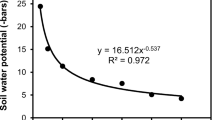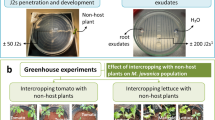Abstract
The vertical migration of second-stage juveniles (J2) of Meloidogyne floridensis and M. incognita was investigated in segmented 14-cm long PVC soil columns having their top ring in contact with soil of a potted plant. Both bottom and top rings were screened appropriately to allow only upward nematode movement and preventing root penetration from the potted plant into the soil in the column. Plants used for nematode’s stimuli were the nematode attractive tomato (Solanum lycopersicum L.) ‘Cobra’ and the nematode repellent French marigold (Tagetes patula L.) var. Petite. Host-free columns were used as control. Columns with and without plants were placed in growth chambers at 20 °C and inoculated with each root-knot nematode species by injecting 1000 J2 through a hole in the basal ring of each column. Columns were dismantled at 3, 6 and 9 days after injection and J2 were extracted from soil of each ring and the planted pot; additionally, roots in the top pot were stained to observe J2 penetration. No preferential upward migration towards either plant stimuli was observed, but M. floridensis was more migrant than M. incognita, with 4.4% and 1.6% of active J2, respectively, reaching an upward distance of more than 13 cm regardless of plant stimuli. This study supports random migration of root-knot nematode J2, even without stimulus from a host plant.




Similar content being viewed by others
References
Barbary, A., Djian-Caporalino, C., Palloix, A., & Castagnone-Sereno, P. (2015). Host genetic resistance to root-knot nematodes, Meloidogyne spp., in Solanaceae: From genes to the field. Pest Management Science, 71, 1591–1598.
Bebber, D. P., Holmes, T., & Gurr, S. J. (2014). The global spread of crop pests and pathogens. Global Ecology and Biogeography, 23, 1398–1407.
Brito, J. A., Dickson, D. W., Kaur, R., Vau, S., & Stanley, J. D. (2015). The peach root-knot nematode: Meloidogyne floridensis, and its potential impact for the peach industry in Florida. Nematology circular 224:7. Department of Agriculture and Consumer Services. Gainesville, FL.
Buena, A. P., Díez-Rojo, M. A., López-Pérez, J. A., Robertson, L., Escuer, M., & Bello, A. (2008). Screening of Tagetes patula L. on different populations of Meloidogyne. Crop Protection, 27, 96–100.
Byrd Jr., D. W., Kirkpatrick, T., & Barker, K. R. (1983). An improved technique for clearing and staining plant tissues for detection of nematodes. Journal of Nematology, 15(1), 142–143.
Castro, C. E., Belser, N. O., McKinney, H. E., & Thomason, I. J. (1990). Strong repellency of the root knot nematode, Meloidogyne incognita, by specific inorganic ions. Journal of Chemical Ecology, 16(4), 1199–1205.
Church, G. T. (2005). First report of the root-knot nematode Meloidogyne floridensis on tomato (Lycopersicon esculentum) in Florida. Plant Disease, 89, 527.
Claverie, M., Bosselut, N., Lecouls, A. C., Voisin, R., Lafargue, B., Poizat, C., Kleinhentz, M., Laigret, F., Dirlewanger, E., & Esmenjaud, D. (2004). Location of independent root-knot nematode resistance genes in plum and peach. Theoretical and Applied Genetics, 108(4), 765–773.
Dusenbery, D. B. (1983). Chemotactic behavior of nematodes. Journal of Nematology, 15(2), 168–173.
Dutta, T. K., Powers, S. J., Gaur, H. S., Birkett, M., & Curtis, R. H. C. (2012). Effect of small lipophilic molecules in tomato and rice root exudates on the behaviour of Meloidogyne incognita and M. graminicola. Nematology, 14(3), 309–320.
Francilino, A. H., Pedrosa, E. M. R., Silva, E. F. F., Rolim, M. M., Cardoso, M. S. O., & Maranhão, S. R. V. L. (2017). Efeito do fluxo de água, isca vegetal e volume de poros do solo na mobilidade de Pratylenchus coffeae. Nematropica, 47(1), 63–73.
Fujimoto, T., Hasegawa, S., Otobe, K., & Mizukubo, T. (2009). Effect of water flow on the mobility of the root-knot nematode Meloidogyne incognita in columns filled with glass beads, sand or andisol. Applied Soil Ecology, 43, 200–205.
Fujimoto, T., Hasegawa, S., Otobe, K., & Mizukubo, T. (2010). The effect of soil water flow and soil properties on the motility of second-stage juveniles of the root-knot nematode (Meloidogyne incognita). Soil Biology &. Biochemistry, 42, 1065–1072.
Haichar, F. Z., Santaella, C., Heulin, T., & Achouak, W. (2014). Root exudates mediated interactions belowground. Soil Biology & Biochemistry, 77, 69–80.
Handoo, Z. A., Nyczepir, A. P., Esmenjaud, D., van der Beek, J. G., Castagnone-Sereno, P., Carta, L. K., Skantar, A. M., & Higgins, J. A. (2004). Morphological, molecular and differential host characterisation of Meloidogyne floridensis n.sp. (Nematoda:Meloidogynidae), a root knot nematode parasitizing peach in Florida. Journal of Nematology, 36(1), 20–35.
Hewlett, T. E., Hewlett, E. M., & Dickson, D. W. (1997). Response of Meloidogyne spp., Heterodera glycines, and Radophilus similis to tannic acid. Journal of Nematology, 29(4S), 737–741.
Hiltpold, I., Jaffuel, G., & Turlings, T. C. J. (2015). The dual effects of root-cap exudates on nematodes: From quiescence in plant-parasitic nematodes to frenzy in entomopathogenic nematodes. Journal of Experimental Botany, 66(2), 603–611.
Huettel, R. N., & Jaffe, H. (1987). Attraction and behavior of Heterodera glycines, the soybean cyst nematode, to some biological and inorganic compounds. Proceedings of the Helminthological Society of Washington, 54(1), 122–125.
Hussey, R. S., & Barker, K. R. (1973). A comparison of methods colleting inocula of Meloidogyne spp. including a new technique. Plant Disease Reporter, 57, 1025–1028.
Jenkins, W. R. (1964). A rapid centrifugal-flotation technique for separating nematodes from soil. Plant Disease Reporter, 48, 692.
Kohli, D., Chidambaranatham, P., Kumar, J. P. T., Singh, A. K., Kumar, A., Sirohi, A., Subramaniam, K., Srinivasan, R., Bharadvaja, N., & Jain, P. K. (2018). Host-mediated RNAi of a Notch-like receptor gene in Meloidogyne incognita induces nematode resistance. Parasitology, 145(14), 1896–1906.
Kokalis-Burelle, N., & Nyczepir, A. P. (2004). Host-range studies for Meloidogyne floridensis. Journal of Nematology, 36, 328 (abstr.).
Lu, Z. X., Sossey-Alaoui, K., Reighard, G. L., Baird, W. V., & Abbott, A. G. (1999). Development and characterization of a codominant marker linked to root-knot nematode resistance, and its application to peach rootstock breeding. Theoretical and Applied Genetics, 99(1–2), 115–122.
Marquez, J., Forghani, F., & Hajihassani, A. (2020). First report of the root-knot nematode, Meloidogyne floridensis, on tomato in Georgia, USA. Plant Disease. https://apsjournals.apsnet.org/doi/10.1094/PDIS-10-20-2286-PDN. Accessed 24 Feb 2007.
Murga-Gutiérrez, S. N., Alvarado-Ibáñez, J. C., & Vera-Obando, N. Y. (2012). Efecto del follaje de Tagetes minuta sobre la nodulación radicular de Meloidogyne incognita em Capsicum annuum, en invernadero. Revista Peruana de Biología, 19(3), 257–260.
Nježić, B., Sutter, N., & Moens, M. (2014). Interaction of Tagetes patula cv. Single gold with the life cycle of the plant-parasitic nematodes Meloidogyne chitwoodi and Pratylenchus penetrans. Russian Journal of Nematology, 22(2), 101–108.
Pinkerton, J. N., Mojtahedi, H., Santo, G. S., & O’Bannon, J. H. (1987). Vertical migration of Meloidogyne chitwoodi and M. hapla under controlled temperature. Journal of Nematology, 19(2), 152–157.
Prot, J. (1976). Amplitude et cinétique des migrations du nématode Meloidogyne javanica sous l’influence d’um plant de tomate. Cahiers – ORSTOM. Série biologie, 6(3), 157–166.
Prot, J. (1978). Horizontal migrations of second-stage juveniles of Meloidogyne javanica in sand in concentration gradients of salts and in a moisture gradient. Revue de Nématologie, 2(1), 17–21.
Prot, J. (1980). Migration of plant-parasitic nematodes towards plant roots. Revue de Nématologie, 3(2), 305–318.
Prot, J., & van Gundy, S. D. (1981a). Effect of soil texture and the clay component on migration of Meloidogyne incognita second-stage juveniles. Journal of Nematology, 13(2), 213–217.
Prot, J., & van Gundy, S. D. (1981b). Influence of photoperiod and temperature on migrations of Meloidogyne juveniles. Journal of Nematology, 13(2), 217–220.
Pudasaini, M. P., Viaene, N., & Moens, M. (2007). The influence of host and temperature on the vertical migration of Pratylenchus penetrans. Nematology, 9(3), 437–447.
Rasmann, S., Ali, J. G., Helder, J., & van der Putten, W. H. (2012). Ecology and evolution of soil nematode chemotaxis. Journal of Chemical Ecology, 38(6), 615–628.
Reighard, G. L., Henderson, W. G., Scott, S. O., & Subbotin, S. A. (2019). First report of the root-knot nematode, Meloidogyne floridensis infecting Guardian peach rootstock in South Carolina, USA. Journal of Nematology, 51, 1–3.
Reynolds, A. M., Dutta, T. K., Curtis, R. H. C., Powers, S. J., Gaur, H. S., & Kerry, B. R. (2011). Chemotaxis can take plant-parasitic nematodes to the source of a chemo-attractant via the shortest possible routes. Journal of the Royal Society Interface, 8(57), 568–577.
Rocha, F. S., Campos, V. P., Fernandes, M. F. G., & Muniz, M. F. S. (2016). Migration and reproduction of Meloidogyne incognita in two soil textures. Nematropica, 46(2), 162–171.
Rodríguez-Kábana, R., & Pope, M. H. (1981). A simple incubation method for the extraction of nematodes from soil. Nematropica, 11(2), 175–186.
Salame, L., & Glazer, I. (2015). Stress avoidance: Vertical movement of entomopathogenic nematodes in response to soil moisture gradient. Phytoparasitica, 43, 647–655.
Santos, M. S. N. A. (1973). Mobility of males of Meloidogyne spp. and their responses to females. Nematologica, 19, 521–527.
Sharpe, R. H., Hesse, C. O., Lownsberry, B. A., Perry, V. G., & Hansen, C. J. (1969). Breeding peaches for root-knot nematode resistance. Journal of the American Society of Horticultural Science, 94, 209–212.
Smith, T., Brito, J. A., Han, H., Kaur, R., Cetintas, R., & Dickson, D. W. (2015). Identification of the peach root-knot nematode, Meloidogyne floridensis, using mtDNA PCR-RFLP. Nematropica, 45(1), 138–143.
Sobkowiak, R., Bojarska, N., Krzyżaniak, E., Wagiel, K., & Ntalli, N. (2018). Chemoreception of botanical nematicides by Meloidogyne incognita and Caenorhabditis elegans. Journal of Environmental Science and Health, Part B, 53(8), 493–402.
Spence, K. O., Lewis, E. E., & Perry, R. N. (2008). Host-finding and invasion by entomopathogenic and plant-parasitic nematodes: Evaluating the ability of laboratory bioassays to predict field results. Journal of Nematology, 40(2), 95–98.
Stanley, J. D., Brito, J. A., Kokalis-Burelle, N., Frank, J. H., & Dickson, D. W. (2009). Biological evaluation and comparison of four Florida isolates of Meloidogyne floridensis. Nematropica, 39(2), 255–271.
Steiner, G. (1925). The problem of host selection and host specialization of certain plant-infesting nemas and its application in the study of nemic pests. Phytopathology, 15, 499–534.
Vau, S.J.S.S.O. (2017). Use of the Mi-1 gene carrying tomato (Solanum lycopersicum) for management of root-knot disease in Florida, USA. University of Florida, Gainesville, PhD Dissertation.
Wallace, H. R. (1958a). Movement of eelworms. I. The influence of pore size and moisture content of the soil on the migration of larvae of the beet eelworm, Heterodera schachtii Schmidt. Annals of Applied Biology, 46(1), 74–85.
Wallace, H. R. (1958b). Movement of eelworms. II. A comparative study of the movement in soil of Heterodera schachtii Schmidt and of Ditylenchus dipsaci (Kuhn) Filipjev. Annals of Applied Biology, 46(1), 86–94.
Wallace, H. R. (1958c). Movement of eelworms. III. The relationship between eelworm length, activity and mobility. Annals of Applied Biology, 46(1), 662–668.
Wallace, H. R. (1959). Movement of eelworms. IV. The influence of water percolation. Annals of Applied Biology, 47(1), 131–139.
Wallace, H. R. (1960). Movement of eelworms. VI. The influences of soil type, moisture gradient and host plant roots on the migration of the potato-root eelworm Heterodera rostochiensis Wollenweber. Annals of Applied Biology, 48(1), 107–120.
Wallace, H. R. (1968). The dynamics of nematode movement. Annual Review of Phytopathology, 6, 91–114.
Westphal, A., Maung, Z. T. Z., Doll, D. A., Yaghmour, M. A., Chitambar, J. J., & Subbotin, S. A. (2019). First report of the peach root-knot nematode, Meloidogyne floridensis infecting almond and root-knot nematode resistant ‘Hansen 536’ and ‘Bright’s hybrid 5’ rootstocks in California, USA. Journal of Nematology, 51, 1–3.
Acknowledgments
This study was supported by a Scholarship Grant (PDSE - 88881.134606/2016-01) from the Brazilian Federal Agency for Support and Evaluation of Graduate Education (CAPES).
Author information
Authors and Affiliations
Corresponding author
Ethics declarations
Conflict of interest
The authors declare that they have no conflict of interest.
Research involving human participants and/or animal
The research did not involve human participant or animals.
Informed consent
N/A
Rights and permissions
About this article
Cite this article
de Sá Leitão, D.A.H., Pedrosa, E.M.R., Dickson, D.W. et al. Upward migration of second-stage juveniles of Meloidogyne floridensis and M. incognita under different plant stimuli. Eur J Plant Pathol 161, 301–311 (2021). https://doi.org/10.1007/s10658-021-02322-8
Accepted:
Published:
Issue Date:
DOI: https://doi.org/10.1007/s10658-021-02322-8




